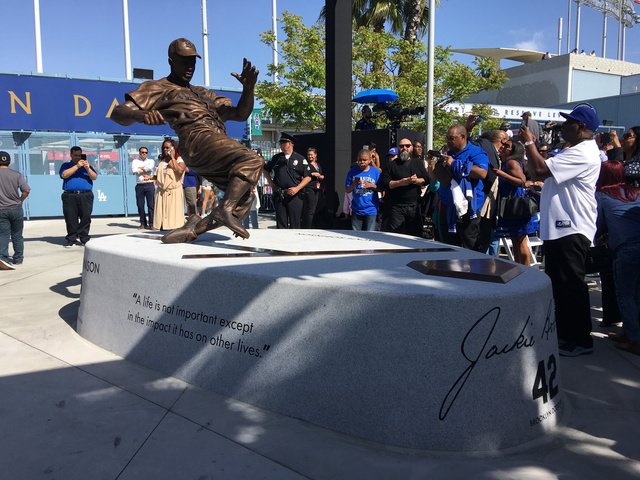What Would Jackie Robinson Want Us To Do?
By Alan Abrahamson | 4/17/17 |
A very few moments in sports have sparked change well beyond. For starters: Jesse Owens in Berlin, Jackie Robinson breaking baseball’s color barrier and Tommie Smith and John Carlos on the medals stand in Mexico City.
Saturday marked the 70th anniversary of Robinson’s Major League Baseball debut with the Brooklyn Dodgers. Now it’s time to pay it forward, and do the right thing by Robinson and get more young men, and particularly young men of color, back into the game.
A little personal history.
I grew up in Ohio, northwest of Dayton. This was Cincinnati Reds territory. My childhood hero was Pete Rose. Perhaps there’s a direct line to becoming a skeptical sportswriter when, as a kid, Pete Rose is your idol — but I digress.
In the 1970s, the Reds and the Dodgers (by then well-established in LA) were rivals. I was all Big Red Machine. Even so, I knew all about Jackie Robinson, who had retired years before. If you know anything about baseball, and in southwestern Ohio it was a mark of respect to know baseball history, you especially knew about Jackie Robinson.
You knew, for instance, how in 1947, at a game in Boston, the opposing team’s players were heckling the Dodgers and in particular Pee Wee Reese, the stellar Dodger shortstop, for playing ball with a black man. Reese said nothing. He walked over to Robinson and put his hand on Robinson’s shoulder. That shut everyone up.
Reese was from Louisville, Kentucky. That was the South. But Louisville was also Reds territory. The people I was going to high school with often had relatives — if not parents — who came from Kentucky or Tennessee. Dayton is roughly 50 miles north of the Ohio River. (For those not familiar with American geography, the Ohio River separates North from South in the United States.)
Jackie Robinson’s story — the Dodger story in those years — is superbly told in Roger Kahn’s 1972 “The Boys of Summer.”
That book was the most excellent inspiration for a teen-age boy in the cornfields of southwestern Ohio who could only hope, one day, to be a sportswriter.
The book was published in February 1972. I read it and re-read and re-read it all that spring and summer. Jackie Robinson died that October, three days after my birthday.
“A life is not important,” Robinson once said, “except in the impact it has on other lives.”
Martin Luther King Jr. once told the pitcher Don Newcombe, another Dodgers star and, like Robinson, a former Negro League standout, “You’ll never know what you and Jackie and Roy [Campanella, the Dodger catcher] did to make it possible to do my job.”
Fast forward:
Every April 15, every Major League team honors Robinson, with every player on every team wearing his jersey, No. 42. On Saturday, the Dodgers unveiled a statue at Chavez Ravine.
The Jackie Robinson statue has officially been unveiled at Dodger Stadium.
It’s not much of a reach to suggest that it is because of Robinson’s influence that baseball ultimately went global, why baseball (and softball) are back in the Olympics for 2020, why the president of the World Baseball Softball Confederation, the Italian Riccardo Fraccari, was recently in the east African nation of Mozambique for talks aimed at setting up a national federation there.
You know the saying: act global, think local?
Much has been written about the declining percentage in recent years of black players in the majors.
That percentage grew steadily from Robinson’s 1947 debut until the 1970s. At that point it stayed steady — about 16 to 19 percent — for about 25 years, 1972 to 1996. Since then, it has dropped significantly. In the 2016 season, the figure was 6.7 percent.
It is worth pointing out that for the past dozen or so years, more than half of all players in the major leagues have been pitchers — and there are now 10 times as many Latino pitchers as there are African-Americans.
It’s also worth pointing out something else.
If you are a talented 13- or 14-year-old African-American athlete, and you — and, especially, your folks — are looking up and out, there’s an elemental question: which sport offers the most economic opportunity?
Sifting the numbers and weighing the options, ask, too: isn’t there something pretty obvious that ought to be done here?
— Football.
Football is what’s called a “headcount” sport. One scholarship equals one guy. Math: 129 Division I schools, 85 full scholarships per school. Here you can read this, and more: the average FBS scholarship during the 2015-16 academic year amounted to just over $36,000.
— Basketball
Men’s Division I is also a headcount sport. A men’s team gets 13 full scholarships. There are 351 Division I schools. The value of an average basketball scholarship: again, just over $38,000.
— Baseball
There are 299 Division I baseball programs. Each team can offer a maximum of precisely 11.7 scholarships. Baseball, however, is not a headcount sport. It is instead what is called an “equivalency” sport. This means those 11.7 scholarships can be divided between a maximum of 27 players, with all players on scholarship receiving at least a 25 percent scholarship.
This quickly becomes a math problem. Emphasis on problem.
With the increasing focus on concussions and other potential health issues in football, baseball has a huge opportunity to sell itself to young men and their parents. But only if some forward-thinking grown-ups at the NCAA, MLB, the Olympic world and private sector come together to figure out how to do what might right now might seem impossible.
Of course that’s what was facing Jackie Robinson in 1947, too.






COMMENTS